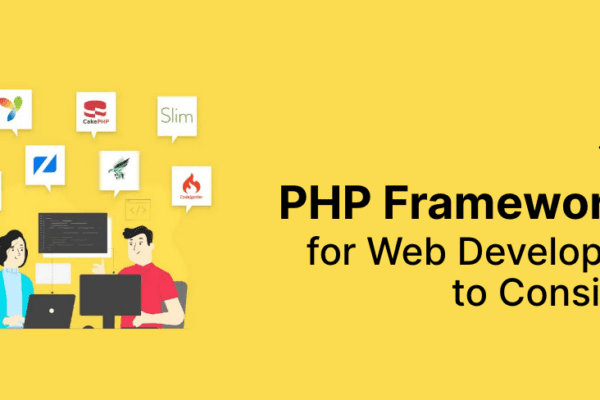The digital landscape has undergone remarkable changes over the years. They have shaped how we interact, create, and innovate online. This concise guide takes you through the most significant web development trends.
We’ll examine the evolution of AI and machine-learning technologies that seamlessly integrate into web functionality. From the introduction of responsive design, which revolutionized cross-device compatibility, to JavaScript frameworks, which empower dynamic and interactive user experiences, we will explore the advancement of AI and machine learning technologies.
The growing importance of web security and the widespread adoption of HTTPS have redefined data integrity and user trust.
Join us to explore the world of Progressive Web Apps and Single Applications, changing the paradigm of Web Architecture. We will also discuss the advent of serverless computing and how it optimizes scalability. This blog captures the timeless web development trends that have shaped the digital world and continue to guide its future trajectory.
Incredible 17 Web Development Trends

Over the next few years, these trends will continue to grow in popularity. Here are the top web development trends for 2023.
1. Progressive Web Apps
PWAs are leading web development trends. However, the latest version will eventually replace web applications. Apps such as Google Maps can function offline with PWAs. PWAs will be used by more companies in 2023. The use of smartphones and tablets to complete various online tasks has never been more important than converting web applications to PWAs.
PWAs not only offer a superior user experience but also provide additional benefits, such as reduced web development costs and seamless maintenance by the provider. As with regular web pages, they also look and behave the same. Angular, HTML, CSS, JavaScript, React, WebAssembly, and React will be used to build Progressive Web Apps by 2023.
2. Responsive Web Design
The Responsive Web Design trend is an important one in web design. It allows websites to adjust seamlessly to different devices and screen sizes. It involves creating fluid and flexible elements that adjust automatically based on whether the device is a smartphone, tablet, or desktop. Rather than having separate desktop and mobile versions, RWD improves the user experience.
This results in a consistent and user-friendly user interface. This web development trend acknowledges that users have different ways of accessing content. It emphasizes the importance of providing an optimal viewing experience on all devices.
3. Single-page applications (SPAs)
Single-page applications (SPAs), a popular web development trend in web design, are gaining popularity. Unlike multi-page websites that load multiple HTML pages, SPAs only load a single HTML and update the content dynamically as users interact with an application.
It reduces page reloads and improves responsiveness, which results in a better user experience. SPAs use JavaScript frameworks such as React, Angular, or Vue.js for managing data and rendering content.
SPAs provide a more app-like experience by focusing on efficiently handling data and minimizing server requests. They require careful consideration for search engine optimization (SEO) and initial loading time, often mitigated by server-side rendering and code-splitting techniques.
4. API First Development
API-First Development, a new approach to Web Development Trends, prioritizes the design and development of the API (Application Programming Interface) before creating the front end.
This strategy encourages seamless integration of systems to enable efficient communication and data transfer. Prioritizing API architecture allows developers to ensure flexibility and reuse, allowing multiple client applications, such as web, mobile, or third-party services, to interact with the backend.
This trend facilitates team collaboration, speeds up development cycles, and allows for the creation of robust, modular applications.
5. WebAssembly is a Web-based Assembly Language.
WebAssembly, or Wasm, is a new web development trend enabling high-performance code execution in browsers. It enables developers to compile code in programming languages like C++ and Rust into a compact binary file with near-native speeds.
This breakthrough breaks free of the limitations of JavaScript, allowing developers to create complex applications, games, simulations, and more directly in browsers. Wasm improves the user experience by bridging between web applications and native apps. Its potential goes beyond front-end design, opening up opportunities for computationally demanding tasks. It propels the web to more prosperous and more versatile online experiences.
6. Optimized voice search
Voice-activated interactions are a popular web development trend focusing on improving user experience. Websites are adapting their design to support voice-driven searches as more users interact with smart speakers and voice assistants.
Developers optimize content for natural-language usage, use schema markup for better search results, and ensure fast loading times for searches initiated by voice. This web development trends highlights the importance of designing voice-friendly interfaces with accurate and concise answers. Voice search optimization allows websites to cater to the increasing audience that relies on voice technology as a convenient and seamless way of interacting online.
7. Serverless Architecture
The serverless architecture trend is a web design approach that eliminates the need to manage traditional server infrastructure. Cloud providers manage scalability, resource allocation, and other aspects of cloud computing while developers focus on writing code.
It reduces operational complexity and allows efficient resource utilization since computing power is dynamically allocated based on demand. Events, such as user interactions, trigger serverless functions. This web development trend simplifies development, increases costs, and allows rapid scaling. It is ideal for modern web apps.
8. Continuous Integration and Deployment
Continuous Integration and deployment (CI/CD), a web development trend, is an important one that improves efficiency and reliability. CI/CD automates code integration, allowing developers to merge code into a repository frequently.
This automated process detects bugs early and ensures a stable codebase. The “CD” component, which automates software deployment to production environments, allows for a rapid and consistent release. CI/CD reduces manual intervention, which speeds up development cycles and improves collaboration.
It also reduces the chance of bugs being released to users. This web development trend creates a dynamic ecosystem where teams can innovate quickly and confidently and deliver high-quality applications.
9. Cloud Computing
Cloud Computing has revolutionized Web Development. It offers scalable infrastructures and services via the Internet. Hire web developers to host and deploy web applications, as well as manage them, without the need for a physical server.
This web development trends allows for rapid development as resources are provisioned based on demand. As a subset of cloud computing, serverless computing abstracts server management from developers and allows them to focus solely on their code. Cloud services improve collaboration between development teams and ensure high availability and safety.
Cloud Computing is a crucial trend as businesses adopt remote work and users’ demands change. It empowers custom web development companies to create resilient, agile, and accessible web applications.
10. AI-powered chatbots
AI-powered chatbots have become a dominant web design trend, revolutionizing how users interact. These virtual assistants use artificial intelligence to engage in real-time conversation with users, improving customer service and user experience. They integrate natural language processing to understand and answer queries contextually.
It allows them to offer personalized assistance. These chatbots facilitate e-commerce and information retrieval on websites. They also foster seamless, 24/7 interactions. This web development trend highlights AI’s increasing importance in redefining online communication dynamics, elevating engagement, and shaping modern webscapes.
11. Complete B2B SaaS Solution
Web development solutions that are complete B2B SaaS solutions integrate the latest industry trends. It is essential to emphasize responsive design to ensure seamless use across all devices. Adopting a serverless architectural model for efficient scaling and implementing APIs will also help.
AI enhances functionality by enhancing AI-driven analytics and personalized features. Clients can trust security measures such as HTTPS and protocols for data privacy. Prioritizing accessibility will ensure usability for everyone.
The solution can also use static site generators to speed up loading times and web components to create a modular design. The forward-looking B2B SaaS approach includes staying up-to-date with new technologies such as WebAssembly and following user-centric motion UI guidelines.
12. Dark Mode UI
Dark Mode UI, a web development trend, is where interfaces use darker color schemes rather than the traditional light background. This style saves battery life on OLED screens and reduces eye fatigue, particularly in low-light situations. Dark themes are being incorporated into applications and websites to give users a more comfortable and appealing experience.
Dark mode is readable and accessible because it uses contrasting colors and calibrated elements. Dark mode is a popular web development trends choice as users seek more customization options. It also enhances user engagement and keeps up with current design trends.
13. Motion UI
Motion UI, a web design trend, aims to enhance user experience through subtle animations. Motion-based interfaces guide users intuitively and make interactions more enjoyable.
These animations act as visual cues that improve navigation and highlight important content. Motion UI doesn’t mean flashy effects.
It means using animations for context and feedback to create a seamless and user-friendly experience. This web development trends acknowledges the importance and benefits of an interactive, dynamic web. It also helps to make websites more responsive and modern.
14. Blockchain Technology
Blockchain technology is a new trend in web design. It involves the creation of decentralized and tamperproof digital ledgers to enhance security and transparency.
Integrating blockchain into web development provides many benefits, such as transparent transaction histories and secure user authentication. Smart contracts powered by blockchain automate transactions and processes, streamlining operations.
Implementing blockchain in web design requires special skills and considerations of scalability. Web Development Companies are looking for ways to make blockchain-based applications more user-friendly and efficient as the technology matures. These web development trends will lead to a more trustworthy and secure online experience.
15. Push Notifications
PushPush notifications are the best web development trends technique that increases user engagement. Websites can send updates in real-time to the users’ devices even if they are not open. This feature is handy for social media, news, and e-commerce platforms.
Developers can use web APIs to implement push notifications that update users about new content, interactions, or offers. This proactive approach increases user interaction and retention, creating a dynamic browsing experience. Modern web development has evolved to include push notifications as users expect instant updates. It ensures that websites are engaging and relevant in the fast-paced digital world.
16. Internet of Things (IoT).
The Internet of Things is a web development trend that encompasses the interconnection of objects of daily use via the Internet. This trend involves developing web applications to interact with and control smart devices, enabling remote monitoring and data collection.
Web developers must now create user interfaces that seamlessly connect users with their IoT devices, usually through responsive design and data visualization in real-time. Due to the sensitive nature of IoT data, security is paramount. Web developers need to adapt as IoT expands. They must master technologies such as MQTT and CoAP to communicate and ensure robust backend systems that can manage the data influx from connected devices.
17. Accelerated Mobile Pages
Accelerated Mobile Page (AMP) is an emerging web development trends that focuses on improving the performance of mobile sites.
It is designed to reduce loading time by removing unnecessary elements and using restricted technologies. Google caches and pre-renders AMP pages, which results in near-instantaneous loading times, an enhanced user experience, and reduced bounce rates.
AMP is especially beneficial for content-heavy sites, publishers, ecommerce and e-commerce. While AMP improves speed, there are limitations, such as a simplified design and limited JavaScript capabilities. AMP is still relevant for businesses as they strive to provide mobile users with engaging and fast browsing experiences.
How DeveloperpersPerHour Can Help You In Web Development With These Trends?
DevelopersPerHour excels in harnessing cutting-edge web development trends to elevate your projects. Our adept team crafts responsive designs, guaranteeing flawless user experiences on diverse devices. With expertise in Progressive Web Apps, our developers create lightning-fast, installable web experiences.
DevelopersPerHour’s grasp of serverless architecture ensures scalable, efficient solutions. Our developers integrate AI for enhanced personalization and efficiency. Accessibility and security are paramount in their approach, aligning with modern standards.
Our proficiency in Accelerated Mobile Pages boosts mobile site speed. Hire dedicated developers from DevelopersPerHour to empower your web development journey with trend-focused solutions that captivate users and elevate your online presence.
Frequently Asked Questions
Q1. What is responsive web design (RWD)?
The responsive web design allows websites to adapt seamlessly to different screen sizes and provide an optimal user experience. This dynamic responsiveness is achieved using media queries, fluid images, and flexible layouts.
Q2. What is the difference between traditional apps and progressive web applications (PWAs?
PWAs offer offline access and push notifications, as well as faster loading. They do not require installation and provide a native-app experience in web browsers.
Q3. What are the benefits of a serverless architecture for web development?
The serverless architecture allows developers to concentrate on their code without worrying about managing server infrastructure. It improves scalability and reduces operational overhead.
Q4. What is the role of Artificial Intelligence in Web Development Trends?
AI improves the web experience with personalized recommendations, chatbots, and content generation. It increases user engagement and efficiency through automated tasks and tailored interactions.
Q5. Why is accessibility important in modern web design?
It ensures that websites are accessible to everyone, including people with disabilities. It adheres to inclusive design principles and broadens your audience while complying with the legal requirements of equal digital access.











